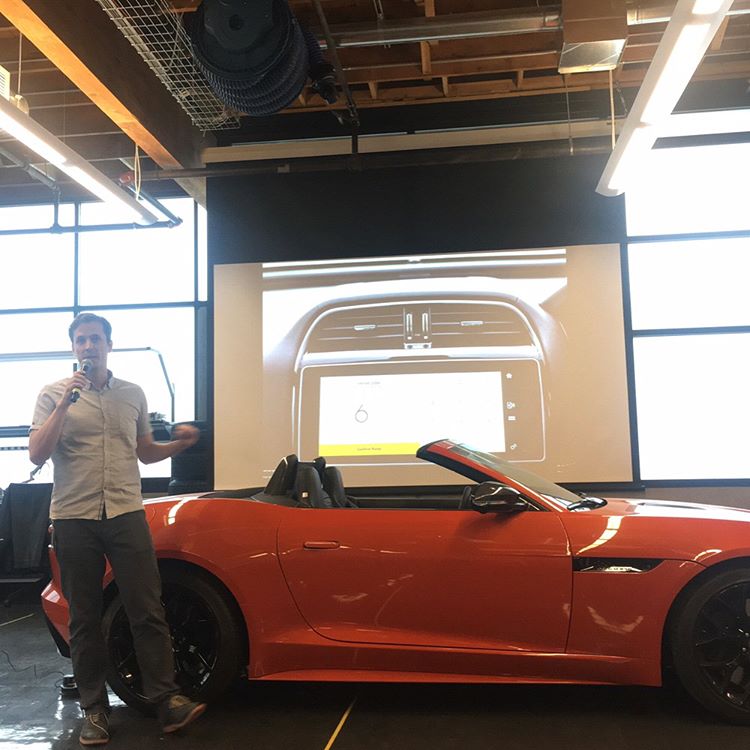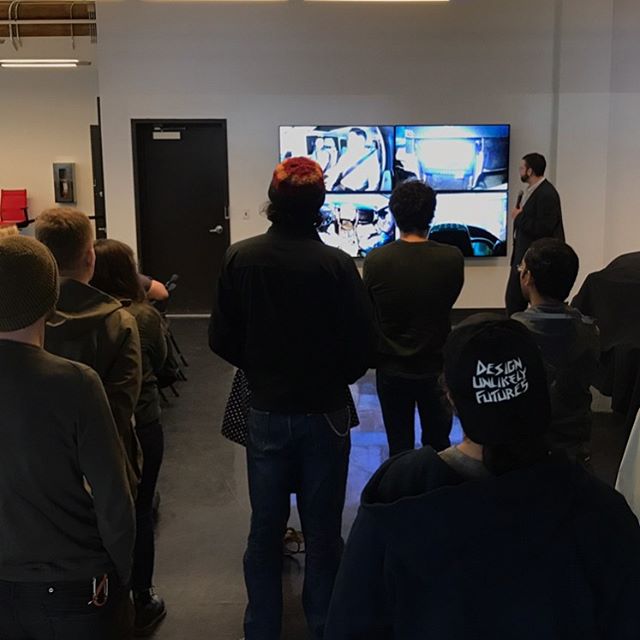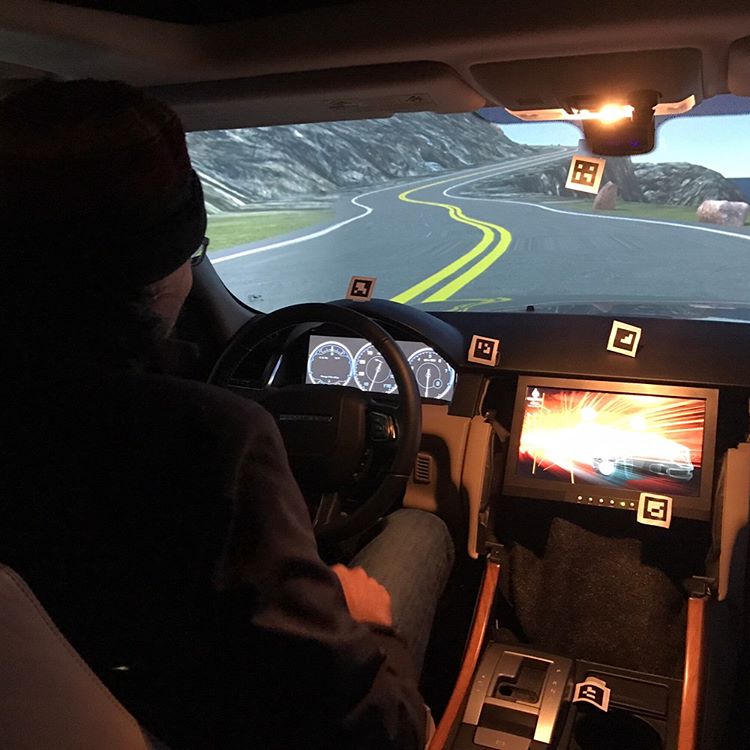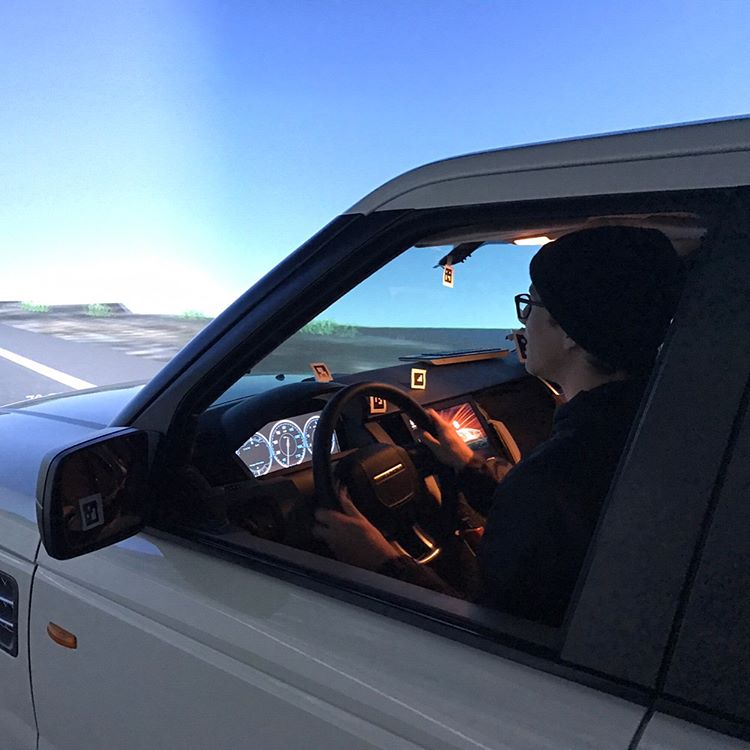On March 15, 2017 the Jaguar Land Rover Open Software Technology Center (OSTC), located in the Pearl District, opened its doors to the AIGA community to share its history, challenges of the automotive industry, and their approach to working with designers and technologists. As expected and most likely due to the secretive nature of the work at OSTC; we were granted a full presentation put together by a group of managers, engineers, user experience developers, and software developers.
The presentation was set in a vehicle workshop where we were surrounded by a Range Rover, a Jaguar XJ, and what looked like a Range Rover but it was all covered up — top secret! So cool. Setting the stage was a fire-orange Jaguar F-Type. The production was top notch.

The tour was moderated by OSTC Lead Feature Owner (and AIGA Portland Board Member, woot!) Salvador Orara, who kicked off the session with a brief introduction and history of the two brands; how they got started, became one, and where they are headed with their new products: the Jaguar iPace and the Range Rover Velar. The history lesson was then followed by a brief look into the User Experience Design challenges the automotive industry faces as whole, by UX Design Manager Jonathan Howe. Jonathan was quick to his point for the eager crowd of designers, “the biggest challenge we face is not other vehicle manufacturers or OEM’s (original equipment manufacturer). It’s the devices in our pockets — the smartphone.” As it turns out smartphones have cornered the market in defining our expectations within digital experiences, and the experiences we think we want, or need to have while driving. It’s a challenge that is ripe for definition, creativity, and innovation.
Jumping into more technical aspects of the business, but at the same time keeping it real for the crowd of designers, Software Development Manager, Paul Wheller identified some of the key challenges with crafting cross-functional teams. With his amazingly crafted slides of caricatures Paul says, “we’re challenged with getting Software Developers to think like Designers, and getting Designers to think like Software Developers.” Paul goes on further by pointing out how important it is for both parties to understand one another through a clear process, principles, and nomenclature. One of the big questions from the AIGA community, “Why an office in Portland?” As one of the original founding members of OSTC, Paul was able to identify some key aspects:
- Location. It’s not quite Seattle and not as expensive as San Francisco.
- Creativity. The strength and growth of the Portland creative community.
- Startups. The growth of the startup market in the Northwest region.
Next, we had Richard Rowe, Collaboration Manager, whose team is responsible for seeking out new technologies, companies, and opportunities for research and development. Specifically, Richard introduced his work with GENIVI®, a non-profit industry alliance (BMW, Hyundai, Intel, and LG to name a few), who are committed to driving the broad adoption of open source, In-Vehicle Infotainment (IVI) software and providing open technology for the connected car. Richard provided an invitation for the group to have a look at the open source style guide, created to enable software developers to create experiences and applications for the GENIVI® open source IVI platform. Richard, invites the Portland design community to have a look at the style guide and to even take a stab at re-designing it!
Getting to the lights and fireworks of the presentation, Aaron Eiche, Lead Software Developer gave a demonstration of his project utilizing the open source GENIVI® RVI (Remote Vehicle Interaction) platform. Utilizing the open source API for Amazon Echo, Aaron created his own “skills” that were connected to the stunning Jaguar F-Type. Using these custom “Alexa…” commands, Aaron demonstrated: locking the vehicle, getting its current location, setting the cabin temperature, and opening and closing the convertible rooftop. Despite some of the technical difficulties of the demonstration, it was super cool to see Aaron “talking” to his car. I would love to set the temperature of my car with a simple voice command… some day.

Connecting all of the dots, User Experience Research Manager, Seb Paszkowicz, showed how the UX Design, Software Development, Technology Research, and Rapid Prototyping feeds into the different Usability and Evaluation Studies. Seb described how “nothing leaves OSTC without being evaluated.” Seb provided a sample video consisting of snippets of a mock user test session where were given a third-person point of view of some of the deep questioning and different technologies used, such as: Occlusion Goggles, Eye Tracking Hardware, and of course the large driving simulator.

After the video, we were invited to some awesome snacks (designers love to eat!) and were given an opportunity for some hands-on experience of the simulator. We also had a chance to have one-on-one conversations with some of the managers and the teams.

Needless to say, this tour set a precedence on an experiential level. There was so much to dig into if we only had more time… or maybe another tour at OSTC. Maybe some swag or giveaways… like a free Jaguar? Hehehe.
♣
For more information about Jaguar Land Rover Open Software Technology Center (OSTC) and their incubator program (the only one in Portland):
https://www.jlrtechincubator.com/jlrti/
For more information on GENIVI®:
https://www.genivi.org/
For more information on GENIVI® projects:
https://at.projects.genivi.org/wiki/display/PROJ/Projects+Home
For the GENIVI® Design style guide:
https://at.projects.genivi.org/wiki/display/GGS/GENIVI+Graphics+Style+Guide